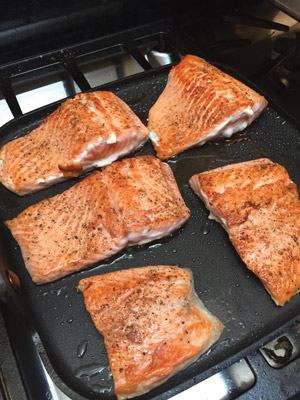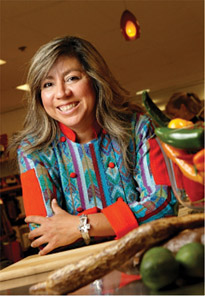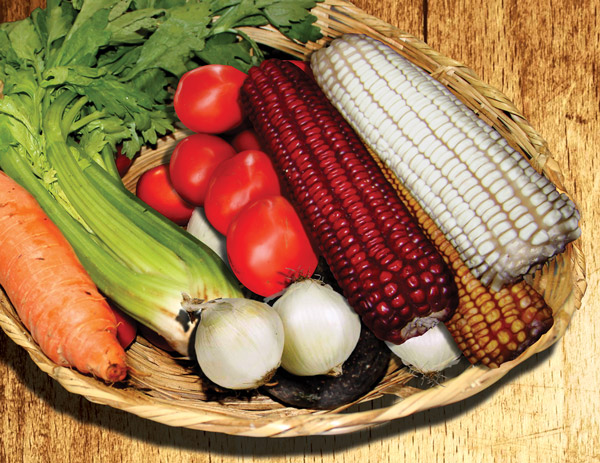AMALIA’S KITCHEN: Latin Gluten-Free and Vegetarian Delights
Guatemalan and Latin cuisine offer many suggestions for making traditional dishes in healthy ways without compromising flavor and quality.
My food philosophy is practical and healthy. I grew up eating lots of fresh fruits and vegetables, legumes, lean proteins, unprocessed foods and healthy oils, such as canola and olive oil. Some Guatemalan cooking uses lard, but my grandmother avoided it because she needed a special diet, so I did not develop a taste for it.
I learned at a young age that foods in their natural state, free of chemicals, are the best. I grew up as an organic-eating locavore—although back then, these terms did not exist.
Guatemalan and Latin cuisine offer many suggestions for making traditional dishes in healthy ways without compromising flavor and quality. Guatemalan cooking can easily accommodate a plant-based diet with low-fat proteins, a gluten-free diet or a vegetarian diet.
Food enters through the eyes and if it looks and smells good, people want to eat it. During my years of cooking professionally, I have learned to adapt many dishes to special diets because my clients demand it, so I have a lot of fun in the kitchen creating new dishes or finding suitable substitutions for traditional meals.
Whether you are challenged by Celiac disease or simply embrace a vegetarian lifestyle, you are in for a treat with Latin cuisine, from one-meal dishes to soups, stews, drinks and many more. As the cultural influences within Latin America vary by country, the opportunities for finding quick, easy and healthy dishes also abound, from Spanish and Asian to African flavors.
I am fond of many types of cooking and at home; I experiment and fuse flavors from other nationalities with Latin cuisine. This keeps me learning and eating delicious food all the time.
For starters, myriad dishes can be made with legumes, corn and rice as a base, or one can look beyond that and expand the ingredient list to other good-for-you ancient super grains such as amaranth, buckwheat, chia seeds, millet, quinoa, sorghum and teff.
All these can be treated as basic ingredients that pack a lot of nutrition and are super easy to cook. Think of these less-common grains as the staples that you have cooked with in the past. That way it will be easier to incorporate them into your eating routine.
Gluten-free and vegetarian cooking gives us the opportunity to expand our diet repertoire while it entices our creativity in the kitchen in an unpredicted way. In my kitchen, when I encounter a new ingredient, I first think of how it resembles other food items, and my creative juices start to flow.
The ancient grains I mentioned above cook very similarly to rice or beans, and you can attach any flavors you like to them. Starchy foods like these absorb flavors fast, so over-flavor them. Quick flavoring sauces like sofritos (tomatoes, onion, garlic, chili peppers plus many herbs) sautéed in olive oil and dressed with lemon juice, work really well with grains and gluten-free pastas.
During super busy weeks, I often rely on a mixture of power greens (romaine, spinach, kale and others) combined with shredded carrots and other vegetables that don’t spoil fast, and use them as a base for one-dish meals at dinner time.
So I top the healthy salad with garbanzo beans (or cooked grains), cubed cooked potatoes, tomatoes, bell peppers, hard-boiled eggs, a triage of fresh herbs (mint, parsley and cilantro), and dress them with olive oil and lemon juice or red wine vinegar.
Recently I smoked a salmon filet that I had previously rubbed with a homemade spice adobo dry mix and smoked it on the stovetop with apple chips and chardonnay. The tenderly delicious and moist spicy fish made my salad divine.
 SIMPLY DIVINE SALMON
SIMPLY DIVINE SALMON
Recipe by Chef Amalia Moreno-Damgaard
2-4 Atlantic salmon filets with skin
Olive oil
Kosher salt and freshly ground black pepper.
Adobo spice rub mix:
combine equal amounts (one tablespoon of each) of dried oregano and thyme, cumin, ground coriander seed, pimento (Spanish paprika), and garlic and onion powder. Or combine less or more of your favorite spices.
The juice of one lemon
Rub the salmon with enough olive oil to coat it thoroughly. Rub with the spice mixture and season with salt and pepper.
Smoke or grill. If you own a stovetop smoker, add a teaspoon of apple chips to the center of the smoking pan and ¼ cup of your favorite liquid (water, wine or other). Arrange the salmon on the rack inside the smoking pan. Slide the lid, but do not close the pan all the way. Set the fire to medium high and as soon as smoke begins to emerge, slide the lid to close completely. Lower the heat to medium and smoke and cook the salmon for 15 minutes.
Alternatively, heat a non-stick griddle on medium heat, drizzle with a bit of olive oil to cover thinly, and place salmon filets on the griddle skin up. Cook until a nice medium brown crust has formed, about 4 minutes. With a wide spatula, carefully turn the filets to the other side and cook for 1-2 minutes for medium rare salmon.
Drizzle lemon juice on the salmon right before serving.
Revue’s “AMALIA’S KITCHEN” by award-winning chef and author Amalia Moreno-Damgaard (AmaliaLLC.com)

